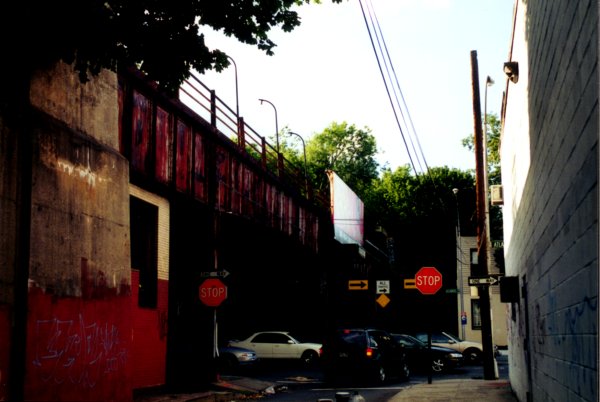
Above, the view northbound from the east side of the
Atlantic Avenue Woodhaven Junction station of the long defunct LIRR Rockaway Line Dead Tracks.
Never
let it be said that the Dead Tracks do no work to earn their dubious keep,
as their occasional overpasses still serve as anchors for the requisite
billboards.
The cut-out section of wall to the left is where one of the two
stairwells leading up to the northbound platforms is. All stairs are still
there, but access up to the platforms is bricked up.

A close-up shot looking up at the platform. The structure
with the rounded corners provided shelter from the weather and covered the
stairwell leading to and from the street. Each platform had two stairwells
and attendant shelters straddling both sides of Atlantic Avenue.
When I shot these in June 2000, the station platform, structures and underside were all
home to a colony of homeless. As of 2003, they still were, despite
occasional raids meant to force them into city run shelters. A major sweep
at that time may well have sealed this makeshift shelter off for keeps, but
I doubt it. I'm sure if I wander by here again, I'll find the same above
ground "underground" community.

Many abandoned
rail stations will look the part from start to finish, with ancient, rusting
and creaky fittings that appear right at home in a ghost town. The Woodhaven station, however, seems strangely out of place in this Twilight Zone
of the railway damned. For one thing, it was not ancient by any stretch when
service along its line stopped, hailing from the early 1940's, making it
a mere twenty years old when abandoned, and newer
than most surviving subway and suburban stations still in use.
The Long
Island Railroad didn't appear to have skimped on its construction either.
The shelters sport the tony cream colored bricks and rounded edges so in
vogue during the Art Deco period of the pre-war Depression years.

Even
the lights that adorned the station platform were a good deal fancier than
the run-of-the-mill bent-pipe-like standards that did sentinel duty at many
contemporary stations. These Art Modernesque standards foreshadowed the
forward look of the jet age fifties, and the closely related jet-style poles
that would later adorn nearby JFK Airport. They could certainly be said to
be grandfathers to the snake-like davit style lampposts. Most of all,
especially given the effect made as the upper mast section lifts off from
its base in the platform railing, these lights almost unquestionably served
as the model for the famed designing engineer Donald Deskey's quirky Art
Moderne lamppost design of 1958 that served as the blueprint for the 1960's
to 1970's era SLECO lampposts that a buddy of mine lovingly nicknamed the
"Big Loops".
For an idea what this station must have looked like in
its more useful heyday, check out the similarly constructed Aqueduct Raceway
station along the A train south of Liberty Avenue, where the southern-most
section of the Rockaway Line still lives on, still the Rockaway Line, but
since 1956 a part of the New York City subway system instead of the Long
Island Railroad. Ironically both the subways, which were then run by the
city's own Transit Authority, and the railroad, which was still a privately
owned, but bankrupt entity, have since 1968 been together in the New York
State Metropolitan Transportation Authority, or MTA as most people refer ro
it.

